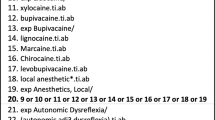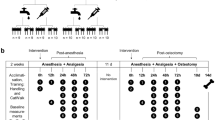Abstract
Study design: Case report.
Objectives: A case report of tolerance to intrathecal baclofen therapy (ITB) treated with intrathecal morphine (‘baclofen holiday’).
Setting: Institut Guttmann, Neurorehabilitation Hospital of Barcelona, Spain.
Case Report: A 30-year-old female patient is described with incomplete paraplegia below T6 on the left side and below T8 on the right side, ASIA B, caused by trauma occurring 12 years previously, in whom an intrathecal system had been implanted for baclofen infusion 10 years ago. The patient showed tolerance to baclofen therapy and was treated with intrathecal morphine infusion for 2 weeks. Baclofen infusion resulted in adequate control of spasticity.
Similar content being viewed by others
Introduction
The efficacy and safety of treatment of spasticity of a spinal origin with intrathecal baclofen therapy (ITB) is well known.1,2,3,4 However, tolerance to baclofen has occasionally been reported in patients after long-term treatment.5,6,7
Tolerance is defined as the condition requiring gradual dose increases of a substance to obtain the same therapeutic effect.
Baclofen (B-(aminomethyl)-4-chlorobenzenepropanoic acid), structurally related to gamma-aminobutyric acid (GABA), is able to inhibit spinal mono- and poly synaptic reflexes by acting on the GABAB receptors located in the posterior horn of the spinal cord (gelatinous substance), causing membrane hyperpolarization and a blockade of Ca2+ channels.
Continuous, persistent occupation of GABAB receptors by baclofen results in a decreased response to the drug due to changes in the receptor.8
This physiological tolerance, usually seen in the first months, is normally stabilized before 1 year of treatment.
However, in some cases of long-term baclofen infusion, a decreasing effect is seen, which persists even with progressive dose increases.
After ruling out mechanical problems in the system, arachnoiditis or an impaired CSF circulation, this phenomenon suggests the presence of tolerance to baclofen caused by a gradual reduction in the number of specific receptors.6,9
The mechanisms by which tolerance develops have not been fully elucidated, and it may be attributed to other complications in the system. It appears that tolerance could be due to some changes in the GABAB receptors or intracellular changes. Some authors suggest that changes occur at the receptor level. The number of receptors decreases after repeated drug infusion, causing the loss of efficacy of baclofen.8,10 Other reports indicate the interaction between GABAB receptor and opioid receptor systems within the spinal cord.11
Case report
We report the case of a 30-year-old female patient with no known drug allergies who suffered paraplegia – incomplete transversal medullary syndrome below the sixth thoracic neurological segment on the left side and below the eighth thoracic neurological segment on the right side – after a car accident occurring on 4 August 1990. On June 1992, she was implanted with an intrathecal baclofen pump, which had to be removed due to infection, and the whole system was replaced in August 1992. Removal of the whole system because of a new overinfection was required again, and it needed to be replaced a third time on 12 March 1995. Since then, spasticity was adequately controlled at infusion doses from 300 to 400 μg/day until 30 January 2001, when the baclofen reservoir had to be replaced due to exhaustion of the lithium batteries. A change in catheter due to malfunction was subsequently required on 30 January 2001. Since then, she required continuous dose increases of the intrathecal baclofen dose up to 650 μg/day. Mild improvements were seen in the first few days after reprogramming, coinciding with dose increases, but the condition worsened again until the new dose increase.
System malfunction or a possible mechanism of tolerance to baclofen was suspected, and the patient was therefore admitted for study on 12 November 2001.
During her hospital stay, adequate function of the pump was verified, possible associated conditions causing the increased spasticity were ruled out, and a neuroimaging study of the thoracolumbar spinal cord was performed with MRI, which showed artefacts related to the posterior arthrodesis implanted in the initial stage of the spine and cord trauma, but no either significant abnormalities.
The condition was considered to result from a po-tential mechanism of tolerance to intrathecal baclofen.
The dose of intrathecal baclofen was gradually reduced until total drug discontinuation, and a bridge infusion of intrathecal morphine was administered for 2 weeks at doses of 1 mg/day. Continuous infusion of baclofen was then restarted on 3 December 2001 at low doses (100 μg/day), which were subsequently increased to the current dose of 300 μg/day, which achieved an adequate control of spasticity of the lower limbs, similar to the control seen before the whole process.
The disappearance of spasticity, Ashworth 0, during morphine infusion in the 2 weeks of specific treatment should also be noted.
Discussion
Penn and Kroin5 were the first to report the effect of tolerance in patients receiving treatment with ITB. Coffey et al6 reported tolerance in 8% of his patients with spinal cord injury and multiple sclerosis, a phenomenon occurring from 3 to 31 months after the pump was implanted.
Meythaler et al7 reported the effect of tolerance to baclofen in five patients on IBT during the first 12 months following implantation.
In the case reported here, tolerance occurred 9 years after pump implantation, with mean doses ranging from 300 to 400 μg/day, and increases in baclofen dose had not been required until the past months, when successive increases only achieved partial reductions in severe spasticity for a few days, and the dose had to be gradually increased subsequently.
Conclusions
The use of a therapy based on ‘baclofen holiday’ for 15 days with intrathecal morphine infusion was shown to be an effective treatment, with minimal complications, and was well tolerated by the patient.
References
Penn DR et al. Intrathecal baclofen for severe spinal spasticity. N Engl J Med 1989; 320: 1517–1521.
Azouvi P et al. Intrathecal baclofen administration for control of severe spinal spasticity: functional improvement and long-term follow-up. Arch Phys Med Rehabil 1996; 77: 35–39.
Becker WJ et al. Long-term intrathecal baclofen therapy in patients with intractable spasticity. Can J Neurol Sci 1995; 22: 208–217.
J Vidal et al. Safety and efficacy of intrathecal baclofen infusion by implantable pump for treatment of severe spinal spasticity: a Spanish Multicenter study. Neuro-modulation 2000; 3: 175–182.
Penn RD, Kroin JS . Long-term intrathecal baclofen infusion for treatment for spasticity. J Neurosurg 1987; 66: 181–185.
Coffey JR et al. Intrathecal baclofen for intractable spasticity of spinal origin: results of a long-term multicenter study. J Neurosurg 1993; 78: 226–232.
Meythaler JM et al. Continuous intrathecal baclofen in spinal cord spasticity: a prospective study. Am J Phys Med Rehabil 1992; 71: 321–327.
Wallace M, Yaksh TL . Long-term spinal analgesic delivery: a review of the preclinical and clinical literature. Reg Anesth Pain Med 2000; 25: 117–157.
Abel NA, Smith RA . Intrathecal baclofen for treatment of intractable spinal spasticity. Arch Phys Med Rehabil 1994; 75: 54–58.
Akmann MN et al. Intrathecal baclofen: does tolerance ocurr? Paraplegia 1993; 31: 516–520.
Hara K et al. The interaction of antinociceptive effects of morphine and GABA receptor agonist within the rat spinal cord. Anesth Analg 1999; 89: 422–427.
Author information
Authors and Affiliations
Rights and permissions
About this article
Cite this article
Vidal, J., Gregori, P., Guevara, D. et al. Efficacy of intrathecal morphine in the treatment of baclofen tolerance in a patient on intrathecal baclofen therapy (ITB). Spinal Cord 42, 50–51 (2004). https://doi.org/10.1038/sj.sc.3101537
Published:
Issue Date:
DOI: https://doi.org/10.1038/sj.sc.3101537
Keywords
This article is cited by
-
Tolerance to continuous intrathecal baclofen infusion can be reversed by pulsatile bolus infusion
Spinal Cord (2010)
-
The incidence and management of tolerance in intrathecal baclofen therapy
Spinal Cord (2009)
-
Place de l’analgésie périmédullaire dans le traitement de la douleur chronique
Douleur et Analgésie (2007)



